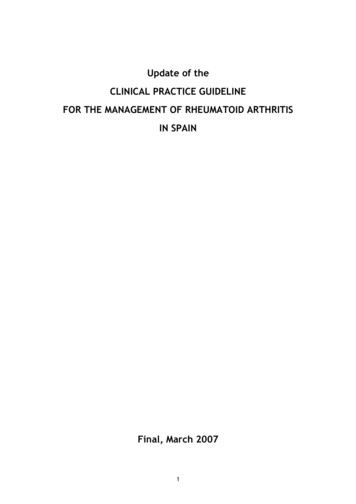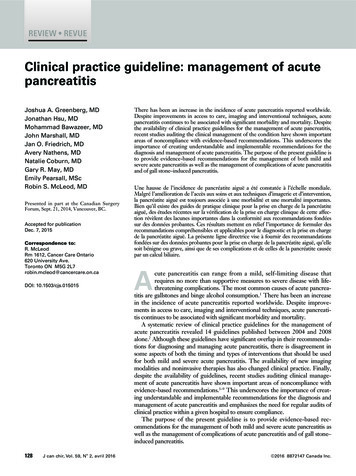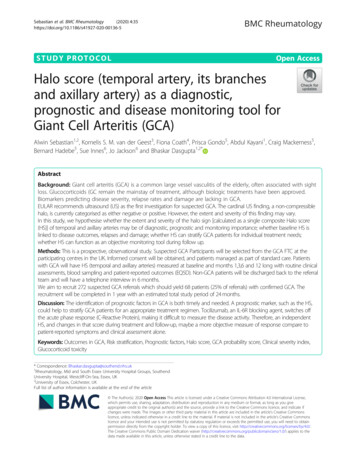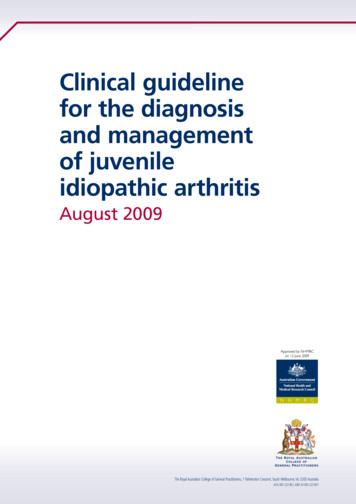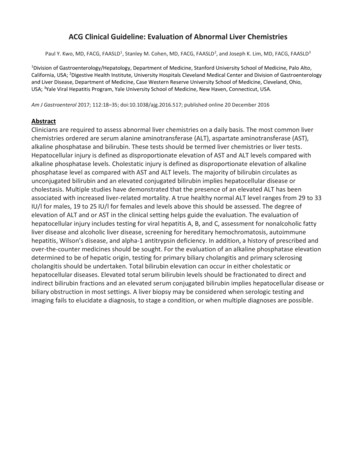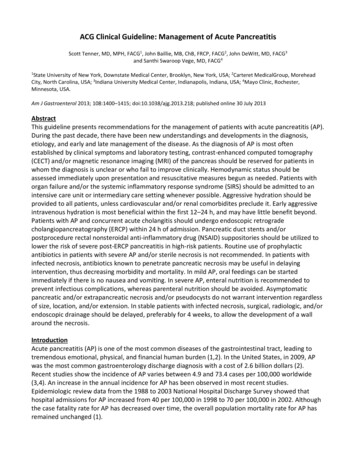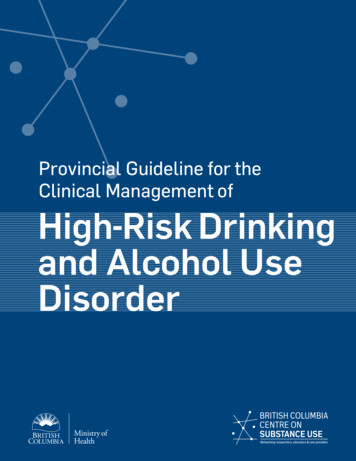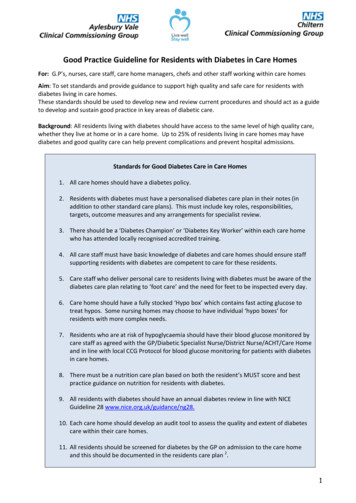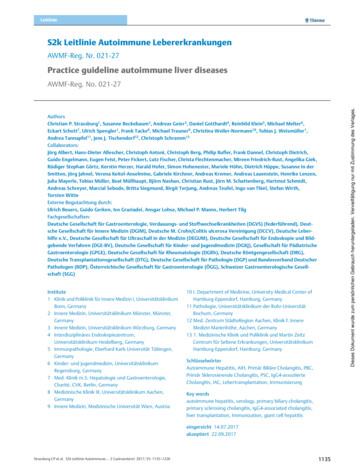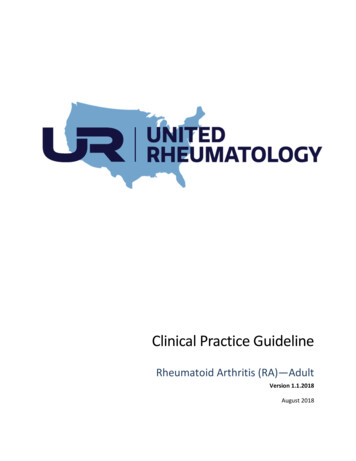
Transcription
Clinical Practice GuidelineRheumatoid Arthritis (RA)—AdultVersion 1.1.2018August 2018
Table of ContentsIntroduction. 5Diagnosis . 8Determining the Diagnosis . 8Laboratory Tests . 11Patient Assessment . 11Imaging . 12Treatment. 13Pharmacologic Therapy Overview . 15Initial Treatment of DMARD‐naïve Patients . 17Methotrexate (MTX) . 18Patients with an Adequate Response to Methotrexate (MTX) at 3 Months . 22Patients with an Inadequate Response to Methotrexate (MTX) at 3 Months . 22Methotrexate Polyglutamate (MTX PG) Levels . 23Patients Receiving Subcutaneous Methotrexate (SQ MTX) Initially . 32Patients with a Contraindication to Methotrexate (MTX) . 32Treatment with boDMARDs, bsDMARDs, or a tsDMARD . 32Monitoring . 36Depression . 37Patient Reported Outcomes (PRO) . 38Glossary . 39Appendix . 40CDAI Calculator . 40References . 41Document Updates . 47United Rheumatology Clinical Practice GuidelineRheumatoid Arthritis (RA)—Adult V1.1.2018Page ii
List of TablesTable 1. Extra‐articular manifestations of RA . 6Table 2. Point allocation for the classification of RA according to the ACR/EULAR criteria . 10Table 3. Disease activity categories according to the CDAI scoring system . 14Table 4. Drugs used in the management of RA. 16List of FiguresFigure 1. Initial pharmacologic management of DMARD‐naïve patients with RA and nocontraindication to MTX . 20Figure 2. Initial pharmacologic management of DMARD‐naïve patients with RA and acontraindication to MTX . 21Figure 3. Pharmacologic management of patients with RA and therapeutic levels ofMTX PG and either 50% improvement in CDAI after 3 months of treatmentwith MTX or failure to attain remission after 6 months of MTX . 25Figure 4. Pharmacologic management of patient with RA and subtherapeutic levels MTX PGwho have had either 50% improvement in CDAI after 3 months of treatmentwith oral MTX or failure to attain remission after 5 months of oral MTX. 26Figure 5. Pharmacologic management of patients with RA and no MTX PG levels with either 50% improvement in CDAI after 3 months of treatment with oral MTX or failureto attain remission after 5‐ 6 months treatment with oral MTX. . 31Figure 6. Pharmacologic management of patients with RA who failed oral or parenteralMTX, leflunomide or hydroxychloroquine, or sulfasalazine but had an adequateresponse to either a boDMARD, bsDMARD, or a tsDMARD. 34Figure 7. Pharmacologic management of patients with RA who failed conventional DMARDsand did not have an adequate response to combination DMARDs or a biologic . 35United Rheumatology Clinical Practice GuidelineRheumatoid Arthritis (RA)—Adult V1.1.2018Page iii
IL‐6IUIUDsLDAMDAMDHAQMRIMTXMTX PGPGPGAPROPtGAPTPN22QoLRARAPID 3RFSQ MTXTBTNFtsDMARDsULNUSVASAnti‐citrullinated protein antibody. Also: anti CCPAmerican College of RheumatologyOriginator biologic disease‐modifying antirheumatic drugsBiosimilar disease‐modifying antirheumatic drugsComplete blood countClinical Disease Activity IndexCenters for Disease Control and PreventionConventional synthetic disease‐modifying antirheumatic drugsC‐reactive proteinDisease activity score, based on 28 jointsDisease‐modifying antirheumatic drugsDepot medroxyprogesterone acetateElectronic health recordsErythrocyte sedimentation rateEuropean League Against RheumatismHepatitis B virusHigh disease activityHuman leukocyte antigen D related beta 1Interleukin 6International unitsIntrauterine devicesLow disease activityModerate disease activityMultidimensional Health Assessment QuestionnaireMagnetic resonance imagingMethotrexateMethotrexate polyglutamatePolyglutamatePhysician Global AssessmentPatient reported outcomesPatient Global AssessmentProtein tyrosine phosphatase non‐receptor type 22Quality of lifeRheumatoid arthritisRoutine Assessment of Patient Index Data 3Rheumatoid factorSubcutaneous methotrexateTuberculosisTumor necrosis factorTargeted synthetic disease‐modifying antirheumatic drugsUpper limit of normalUnited StatesVisual acuity scaleUnited Rheumatology Clinical Practice GuidelineRheumatoid Arthritis (RA)—Adult V1.1.2018Page iv
IntroductionRheumatoid arthritis (RA) is a multisystem autoimmune disease affecting primarily diarthrodial jointsof the hands and feet; however, it can also affect larger joints (shoulder, elbow, hip, ankle, and knee).The disease causes joint inflammation, synovial hyperplasia, and synovitis with increased synovialvascularity. Inflammatory cells within the joint lead to synovial proliferation and pannus formation,which ultimately results in the destruction of articular cartilage and bone.1, 2 Rheumatoid arthritis isthree times more common in women than in men,3 and can begin at any age. However, it is usuallydiagnosed between the ages of 18 and 60 years in women and over the age of 45 years in men.4Although the odds of developing RA are increased in first‐degree relatives of people who have thedisease, most people with RA do not have a family history of it.5The destructive process in RA is thought to be related to an overproduction of a number ofinflammatory cytokines, including tumor necrosis factor (TNF) and interleukin‐6 (IL‐6).6, 7Some important factors possibly associated with an increased risk of RA include:8‐14 SmokingBacteria in the lungsChronic periodontitisSilica exposureAir pollutionChanges in gut floraStudies of families with twins suggest that genetics contribute at least 50% to the etiology of RA.15 Thepresence of human leukocyte antigen D related Beta 1 (HLA‐DRB1) or protein tyrosine phosphatasenon‐receptor type 22 (PTPN22) alleles are associated with an increased risk for RA. However, differentgenetic risks may be seen in different ethnic groups.16, 17Rheumatoid arthritis is frequently but not always associated with the production of auto‐antibodiessuch as rheumatoid factor (RF) and anti‐citrullinated protein antibody (ACPA or anti‐CCP).A more recently described serum marker for RA is 14‐3‐3η. According to Maksymowych et al.,18 theuse of this marker in addition to ACPA and RF may improve the identification of patients with early RAand, when elevated, 14‐3‐3η can be used as a prognostic indicator of more severe disease.In addition to joint destruction, RA is characterized by serious extra‐articular manifestations (Table 1),which tend to occur more frequently in patients with severe, active disease; in those who test positivefor RF and ACPA; in men; and in patients with a history of smoking at the time of diagnosis. Extra‐articular manifestations of RA include rheumatoid nodules, inflammatory eye disease, hematologicabnormalities, Felty’s syndrome, rheumatoid lung, and vasculitis. Extra‐articular manifestations areassociated with increased mortality.19, 20United Rheumatology Clinical Practice GuidelineRheumatoid Arthritis (RA) ‐ Adult V1.1.2018Page 5
Table 1. Extra‐articular manifestations of RAOrgan System/DiseaseExtra‐articular ManifestationPulmonary Pulmonary fibrosisLung nodulesPleural effusionBronchiolitis obliterans organizing pneumoniaCardiac Pericardial effusionMyocarditisEndocarditisSkin Subcutaneous nodulesUlcerationKidneys GlomerulonephritisAmyloidosisEyes Keratoconjunctivitis siccaScleritisEpiscleritisFelty’s syndrome SplenomegalyNeutropeniaVascular Vasculitis (small and large vessel)Other ondary Sjögren’s syndromeMuscle wastingPeripheral neuropathyRheumatoid arthritis is incurable. The disease is characterized by intermittent exacerbations (alsoknown as flares) and is often more active during the first few years after diagnosis. However, withproper management, patients can achieve periods of complete or near complete remission orstabilization of symptoms. Flares can occur, even in patients with previously good control. Flares oracute worsening of inflammation is manifested by increased joint pain and swelling, and systemiccomplaints such as fatigue and difficulty with activities of daily living. Patients should be evaluated assoon as possible during an acute flare, because additions or changes in medication are often neededto regain control.Historically, RA (especially non‐treated or inadequately treated disease) was associated with adecrease in life expectancy by, on average, 5 to 10 years. However, with the availability of bettertreatment, this is no longer the case. A study published in 2016 compared the death rates of patientsdiagnosed with RA between 1996 and 2000 with those diagnosed between 2001 and 2006 and foundthat the death rate in the first 5 years after diagnosis had decreased for those more recentlydiagnosed.21 The authors speculate that this may be due to improved management and better controlof inflammation.United Rheumatology Clinical Practice GuidelineRheumatoid Arthritis (RA)—Adult V1.1.2018Page 6
Patients with RA also have an increased risk for coronary heart disease, even before they arediagnosed with RA, and are more likely than patients without RA to have an unrecognized myocardialinfarction or experience sudden death. They also have an increased risk of stroke, lung cancer,nonmelanoma skin cancer, and lymphoma when compared to the general population.22‐24 Patientswith RA have an increased risk for serious infections, including tuberculosis (TB), which may be relatedto the immunologic abnormalities associated with the disorder as well as the immunosuppressiveeffects of the drugs used to treat this disease.25Patients with RA report a diminished quality of life (QoL) compared to those without arthritis.According to Gabriel et al.,26 15% of patients with RA reported that they were unable to findemployment because of their disease, as opposed to only 3% of those with osteoarthritis and 1% ofthose without arthritis. Patients with RA are more likely to retire early or lose their jobs than thegeneral population. Some patients decrease their work hours voluntarily because of limitations fromtheir illness. In another study, 40% of patients with RA were more likely to report fair or poor generalhealth when compared to nonarthritic controls. They also were 30% more likely to need help withactivities of daily living and twice as likely to have some limitation of activity due to RA.27Rheumatoid arthritis care is very costly. In 2012, Kawatkar et al.28 compared the annual direct medicalcosts associated with caring for these patients with a control group of patients without RA, based onthe 2008 Medical Expenditure Panel Survey. Overall, the annual cost of caring for RA patients was 22.3 billion dollars in 2008. Importantly, the cost of drugs was the greatest contributor to the
Rheumatoid Arthritis (RA) ‐ Adult V1.1.2018 Page 5 Introduction Rheumatoid arthritis (RA) is a multisystem autoimmune disease affecting primarily diarthrodial joints of the hands and feet; however, it can also affect larger joints (shoulder, elbow, hip, ankle, and knee).File Size: 998KBPage Count: 47
